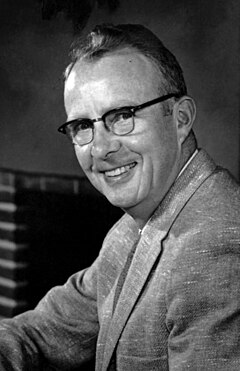Luis Walter Alvarez
| Luis Walter Alvarez | |
|---|---|
 |
|
| Born |
June 13, 1911 San Francisco, California, USA |
| Died | September 1, 1988 (aged 77) Berkeley, California, USA Cancer |
| Resting place | Ashes scattered over Monterey Bay, California |
| Nationality | American |
| Fields | Physics |
| Institutions | University of California, Berkeley |
| Alma mater | University of Chicago |
| Doctoral advisor | Arthur Compton |
| Notable awards | Medal for Merit (1947) National Medal of Science (1963) Nobel Prize in Physics (1968) Enrico Fermi award (1987) |
| Spouse |
Geraldine Smithwick (m. 1936; div. 1957) Janet L. Landis (m. 1958) |
| Signature | |
Luis Walter Alvarez (June 13, 1911 – September 1, 1988) was an American experimental physicist, inventor, and professor who was awarded the Nobel Prize in Physics in 1968. The American Journal of Physics commented, "Luis Alvarez was one of the most brilliant and productive experimental physicists of the twentieth century."
After receiving his PhD from the University of Chicago in 1936, Alvarez went to work for Ernest Lawrence at the Radiation Laboratory at the University of California in Berkeley. Alvarez devised a set of experiments to observe K-electron capture in radioactive nuclei, predicted by the beta decay theory but never observed. He produced tritium using the cyclotron and measured its lifetime. In collaboration with Felix Bloch, he measured the magnetic moment of the neutron.
In 1940 Alvarez joined the MIT Radiation Laboratory, where he contributed to a number of World War II radar projects, from early improvements to Identification Friend or Foe (IFF) radar beacons, now called transponders, to a system known as VIXEN for preventing enemy submarines from realizing that they had been found by the new airborne microwave radars. Enemy submarines would wait until the radar signal was getting strong and then submerge, escaping attack. But VIXEN transmitted a radar signal whose strength was the cube of the distance to the submarine so that as they approached the sub, the signal—as measured by the sub—got progressively weaker, and the sub assumed the plane was getting farther away and didn't submerge. The radar system for which Alvarez is best known and which has played a major role in aviation, most particularly in the post war Berlin airlift, was Ground Controlled Approach (GCA). Alvarez spent a few months at the University of Chicago working on nuclear reactors for Enrico Fermi before coming to Los Alamos to work for Robert Oppenheimer on the Manhattan project. Alvarez worked on the design of explosive lenses, and the development of exploding-bridgewire detonators. As a member of Project Alberta, he observed the Trinity nuclear test from a B-29 Superfortress, and later the bombing of Hiroshima from the B-29 The Great Artiste.
...
Wikipedia
